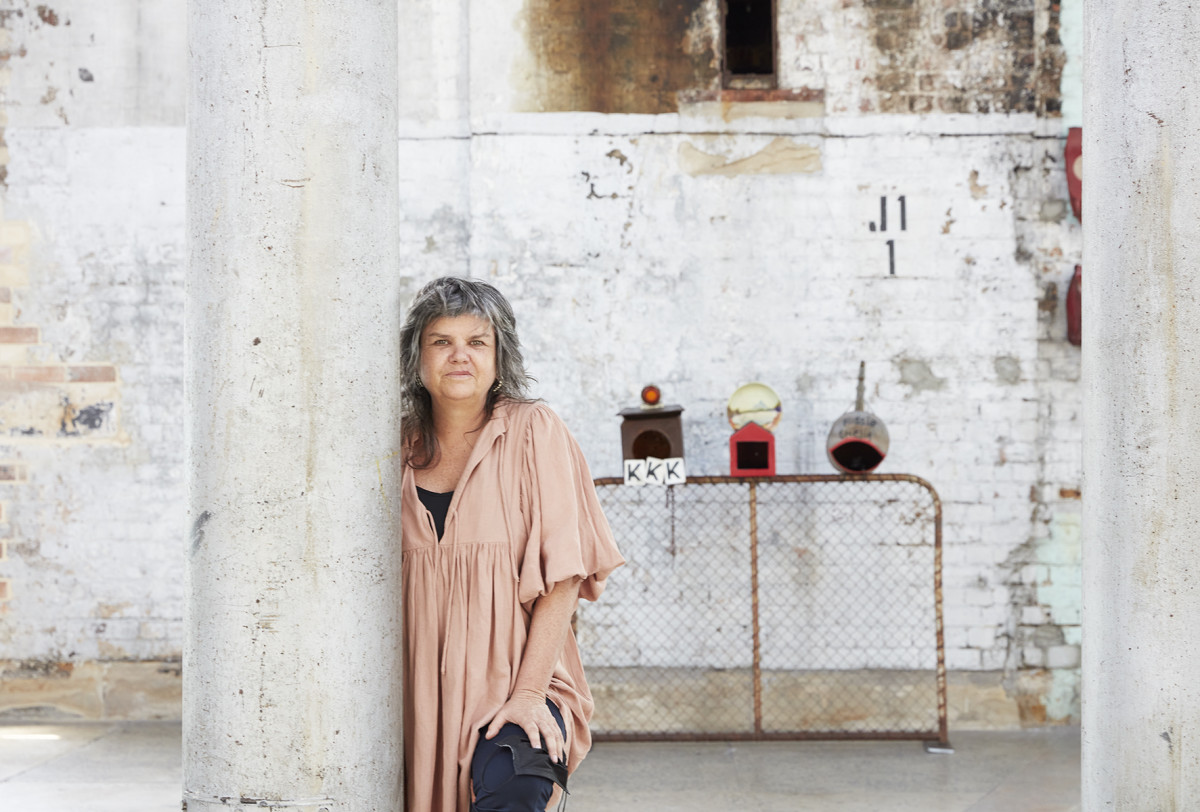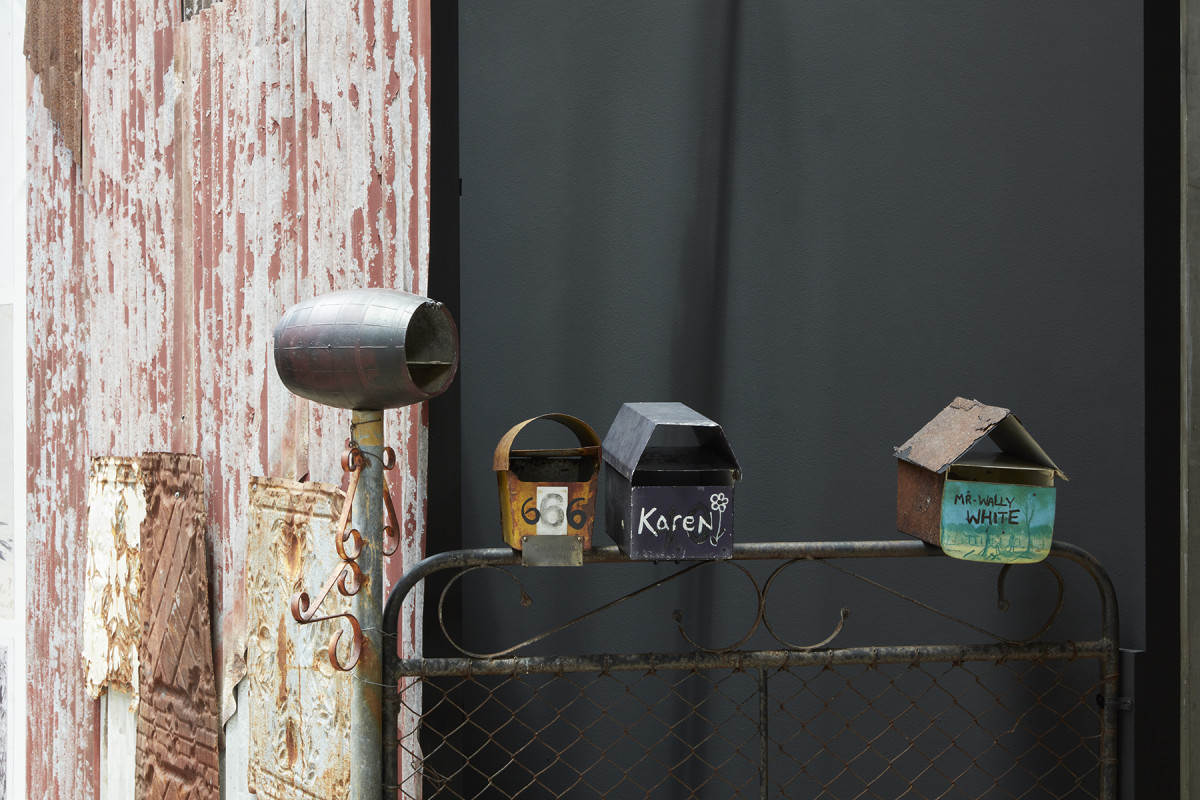 Karla Dickens with a detail of Return to Sender at Carriageworks, 2022
Karla Dickens with a detail of Return to Sender at Carriageworks, 2022Photo: Zan Wimberley
Daniel Mudie Cunningham: Your Wikipedia page says, ‘She loved geography (discovering the world)’. What discoveries did you make living on Eora Nation in South Sydney and Maroubra as a child with Wiradjuri heritage?
Karla Dickens: Yes, I’m a cross-cultural fuck-up! I’m a smooth blend of Irish, Aboriginal, and German ancestry. As a child I did enjoy geography due to a very open-minded teacher at school who was a solid environmentalist. I wrote decent essays inspired by song lyrics, loved art, and sadly would have learnt a lot more if I spent more time there. My best memories where definitely exploring rock pools from Coogee to La Perouse, collecting flotsam and jetsam, walking my dogs, and coming home with flowers from strangers’ gardens.
I was an enthusiastic young child. In primary school I was laden with badges: school captain, sports captain, class captain. Neat and tidy with an ABBA suitcase. Things took a dramatic change when my parents separated – I found drugs and found myself in a new, large, scary pond of an all-girls high school. I found other things I was interested in learning about. In my early teens, my discoveries focused on drugs – I spent countless hours cruising with my dog and living in other worlds.
DMC: Soon after, you went to National Art School (NAS). What made you want to become an artist? What kind of art were you making then?
KD: I had always loved making things as early as I could remember, from Play-Doh to cutting up my dad’s newspapers, making pet cemeteries and endless amounts of beds from matchboxes. It gave me my own space. ‘Off with the fairies’ was often said when I was spoken about. I really got into drawing when I found my brother’s Playboy magazines, I started painting and copying punk album covers, selling t-shirts, making backdrops for bands, and writing many weird stoner diary entries with lots of collage and odd words. I loved listening to psychedelic soundtracks like Rick Wakeman’s Journey to the Centre of the Earth (1974). Retreating to my own world encouraged my love of art. Leaving detox in my mid-20s, NAS was the perfect rehab for me to find a voice. Not that I spoke much or had much to say, but art was a new language that I was totally passionate about. In those days abstract expressionism was the big thing at NAS. I had lots of energy and abstract art made sense; my life drawings were far too energetic and dark for the white male teachers. Then I got into sexy works that were also a bit too much. I guess the beauty in being a rebel without much of a clue was the self-motivation from not giving teachers what they wanted, which made me more passionate about finding what I really wanted to say.
DMC: What were you trying to say?
KD: Whatever they didn’t want me to say.
DMC: At Redfern Station there’s a First Nations community mural from 1998 that proclaims, ‘SAY KNOW TO DRUGS FOR THE NEXT GENERATION’. I walk past it most days and smile when I see your name listed as one of its contributing artists. Was working on this part of the journey you describe? How have you worked with community as part of your practice?
KD: I had been clean for a number of years when the project started. NSW Users and AIDS Association ran workshops and gatherings for months at Redfern’s The Settlement before we actually started working on the mural. There were a number of locals who had never made art previously, so it was a super positive experience for all involved. Self esteem was built, along with a solid sense of respect from the wider community. While all the street art in the area was being destroyed after completion, our mural remained untouched. There was an amazing concert at The Block to celebrate the artists involved with the mural; Archie Roach and Ruby Hunter performed, we had a big feed and the so-called ‘useless addicts’ made good and stood proud. During the 90s I worked with many communities; I facilitated a women’s art group for years, created art with the homeless, worked with kids at Woolloomooloo who struggled with learning difficulties, and taught in jails, to name a few. It was definitely a great way to give back to the wider community.
DMC: In January 2023 you are staging a survey exhibition at Campbelltown Arts Centre tracking 30 years of practice. What does it encompass? And what does it mean for you to reflect on this period through a survey?
KD: It has been an incredible trip down memory lane rediscovering early works, connecting the dots with recurring themes and imagery that I continue to weave in and out of. So I did need to create formal space for the exhibition, which was a great relief, especially for curator Emily Rolfe who I’ve been working with. At one point, I was so excited, I thought it would be a great idea to pull a massive truck of works into the space and install it as a giant collage installation. Grateful to have moved on from that mad tangent. At this point there will be space for A Dickensian Sideshow, The Mother Room (housing environmental based works), and a new series, Disastrous, a room dedicated to a reinvention of Return to Sender that you and I worked on together at Carriageworks (2022). The most challenging and exciting space to curate has been Woman Hear Me Roar Zone, which will include decades of works dating back to the early 90s that explore sex, rape, abuse of women, death, birth and racism. We are attempting to work in a gentle space, but maybe I’m not that artist.
DMC: Why have you called this survey Embracing Shadows?
KD: ‘Embracing shadows’ seems to be the clearest and most direct path I take in the studio when creating art. I know many shadows. It is through my knowledge of these shadows that I have gained freedom, finding the courage to walk with and through them. Even though it can be dark, I do hope viewers will engage with the pockets of humour and leave seeing me as more than just a middle-aged emo.
DMC: I always think of found objects as shadowy. I’m always fascinated by the psychology motivating artists to work with found objects, especially when the objects in question are thrown away or abandoned. What attracts you to them?
KD: Maybe they remind me of myself – so I relate. I am no longer new, I have never been polished; I’m rough, crusty, and bent out of shape. I have always loved used and pre-loved objects – they hold things, they have soul, they knock on peoples’ memories and open doors to other places. Before they know it, people find themselves looking closer at works and relating when they might prefer not to.
 Karla Dickens, Return to Sender, 2022
Karla Dickens, Return to Sender, 2022Photo: Zan Wimberley
DMC: Memory does attach itself to objects in a powerful way. But that memory can also be erased as objects disappear or by the dominant ideological forces that work to keep them hidden. I’m thinking how, for instance, you have used harmful racist imagery from vintage postcards depicting First Nations people in Return to Sender at Carriageworks. What is the motivation for using these objects How do you deal with difficult imagery?
KD: The materials I use confront me and I hope will confront those that live in our country blinded by the heavy weight of denial. These objects and images are solid evidence of the historical racism that has polluted Australia for all of us. I do not want these truths condemned to fire – it is our history, our pains, and I believe our healing. Return to Sender reworked a set of found postcards from the turn of the last century. It felt like a safe opportunity to return and send back the racism. Dealing with the postcards and the handwritten messages displayed was difficult, but so is racism. Towards the end of this creative process, the pain lessened as I started creating several cheeky mailboxes directed to fictitious racists, like Bob Bigot, Wally White and Karen, to name a few. My dark humour was empowering. I do enjoy changing the narrative; often that involves the placement of such pieces alongside other everyday Australian memorabilia, enhanced by titles and poetry that forms part of the works.
DMC: You have been living in the Northern Rivers for a while now. What took you there and how has it informed your practice?
KD: I moved to the Northern Rivers around 20 years ago. Sydney had lost its appeal and became too expensive for this artist. I had lived isolated in the bush for a while but knew I needed to find a community of like-minded humans to save what sanity I had. The Northern Rivers has given me a home on many levels that I needed, one that removes me from finical pressure, giving more time to focus on a meaningful life centred around my daughter and art.
DMC You have become a leader in the community there. Especially through your advocacy work following the devastating floods that hit Lismore in early 2022, a direct result of climate crisis. Given activism has been such a strong part of your practice, how has the politics underlining this catastrophe and its links to the failures of government found expression in your work?
KD: I wouldn’t describe myself as a leader, there are no masters at such times, only humans doing the best they can. The community effort has definitely been the most positive experience facing the impact of the events that unfolded in late February. In times of such devastating need, you really struggle and feel as if you have not done enough. Though in saying that, contributing does create a strong sense of belonging to a place and its people.
After working for Greenpeace at the age of 20, being involved with different campaigns and blockades and witnessing destruction to Country through many impacting factors, you start to think you have some knowledge and awareness. That knowing doesn’t mean much in the middle of a natural disaster; it’s about survival, instinct, and dealing with fear and sheer disbelief. Once I got to the point of acceptance, I had to go back to some form of everyday life; there was no doubt my studio time would be spent creating work that would help me deal with these issues and find some understanding. Recently, I started with a series titled Disastrous consisting of six large works covering the flood, drought, coral bleaching, climate heating, extinction and mining. Doing that work did ground me. I’ve continued working along the same path and can see myself staying focused on that for some time to come.
DMC: Simultaneously, you’ve been working as the curator of Art Byron. Why did you frame the festival through the theme ‘Love or Fear’? How are both interwoven for you?
KD: Love or fear? It’s a question I have asked myself repeatedly since 2019 when the bushfires hit, and in 2020 with Covid, and again this year dealing with the aftermath of the almighty rains. It felt like an obvious theme to put on the table. Personally, I’d like to engage with the artists and the broader community response. It’s probably too big and personal to be taken literally. For me, love and fear are arm-in-arm life experiences; shitting myself with a smile on my face, looking for big girl shoes.
 Karla Dickens, Return to Sender, 2022
Karla Dickens, Return to Sender, 2022Photo: Zan Wimberley
Interview published in Kafay Larday.
Published by Kafay Larday, issue 1 in 2022.